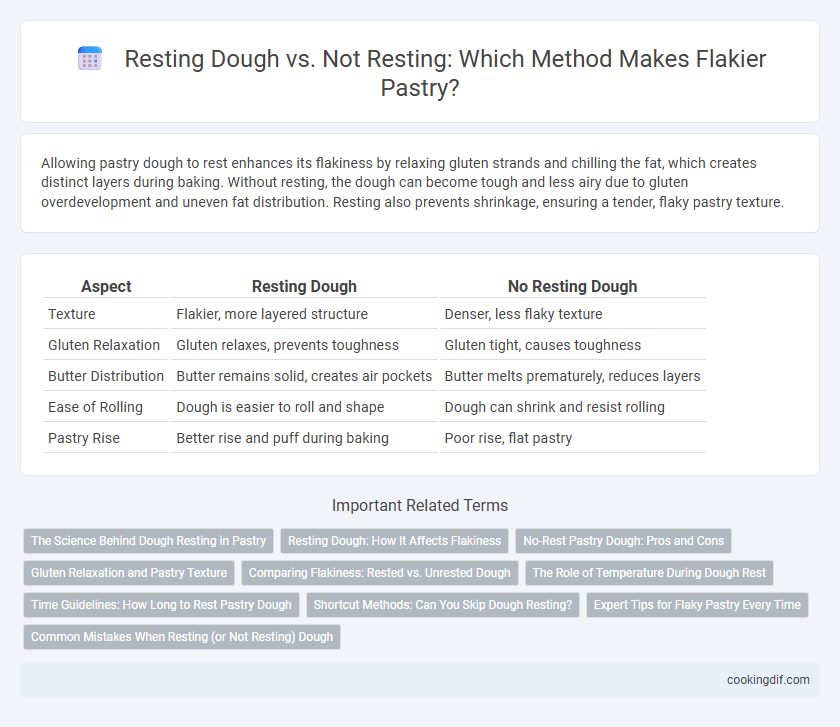Allowing pastry dough to rest enhances its flakiness by relaxing gluten strands and chilling the fat, which creates distinct layers during baking. Without resting, the dough can become tough and less airy due to gluten overdevelopment and uneven fat distribution. Resting also prevents shrinkage, ensuring a tender, flaky pastry texture.
Table of Comparison
| Aspect | Resting Dough | No Resting Dough |
|---|---|---|
| Texture | Flakier, more layered structure | Denser, less flaky texture |
| Gluten Relaxation | Gluten relaxes, prevents toughness | Gluten tight, causes toughness |
| Butter Distribution | Butter remains solid, creates air pockets | Butter melts prematurely, reduces layers |
| Ease of Rolling | Dough is easier to roll and shape | Dough can shrink and resist rolling |
| Pastry Rise | Better rise and puff during baking | Poor rise, flat pastry |
The Science Behind Dough Resting in Pastry
Resting dough allows gluten strands to relax, reducing elasticity and preventing shrinkage during baking, which enhances pastry flakiness. This process promotes even moisture distribution and allows starch granules to hydrate fully, resulting in a tender, layered texture. Skipping resting can cause dough to resist rolling, tear easily, and produce dense, tough pastries.
Resting Dough: How It Affects Flakiness
Resting dough allows gluten strands to relax, preventing toughness and promoting a tender, flaky texture in pastry. Chilling the dough also helps solidify fats, which creates distinct layers during baking, resulting in enhanced flakiness. Pastries made without resting often have a denser, less flaky crumb due to overworked gluten and melted fats.
No-Rest Pastry Dough: Pros and Cons
No-rest pastry dough offers convenience by eliminating waiting time, making it ideal for quick preparation. However, skipping the resting phase can reduce gluten relaxation and hydration, resulting in a less flaky, tougher texture. While no-rest dough suits simple pastries, traditional recipes benefit from resting to achieve optimal flakiness and tenderness.
Gluten Relaxation and Pastry Texture
Resting dough allows gluten strands to relax, reducing elasticity and preventing shrinkage during baking, which enhances the flakiness of pastry. Without resting, gluten remains tight and elastic, resulting in a denser, tougher texture that lacks the desired lightness. Proper dough resting optimizes moisture distribution and promotes even layering, crucial for achieving a tender, flaky crust.
Comparing Flakiness: Rested vs. Unrested Dough
Resting dough enhances flakiness in pastries by allowing gluten strands to relax and fat to solidify, resulting in distinct, tender layers. Unrested dough tends to be tougher and denser because the gluten remains tight and fat melts prematurely during baking. Empirical tests show rested dough produces noticeably lighter, more delicate pastries with consistent lamination compared to unrested dough.
The Role of Temperature During Dough Rest
Resting dough at a cool temperature allows gluten strands to relax, preventing toughness and promoting pastry flakiness. Cold dough maintains fat distribution, ensuring layers do not merge and create a tender, flaky texture. Skipping the resting phase causes the dough to warm and fat to soften prematurely, resulting in less distinct, denser pastry layers.
Time Guidelines: How Long to Rest Pastry Dough
Resting pastry dough for 30 minutes to 1 hour in the refrigerator is crucial for enhancing flakiness, allowing gluten strands to relax and fats to solidify. Without sufficient resting time, typically under 20 minutes, the dough may become tough and less flaky due to overactive gluten development and uneven fat distribution. Optimal resting times vary based on dough type and temperature but generally range from 30 minutes to overnight for best lamination and texture results.
Shortcut Methods: Can You Skip Dough Resting?
Skipping dough resting in pastry preparation often leads to reduced flakiness because resting allows gluten strands to relax and moisture to evenly distribute, which is crucial for a tender and layered texture. Shortcut methods like chilling dough briefly or freezing can partially mimic the effects of resting but typically do not achieve the same level of flakiness as a proper resting period of at least 30 minutes to an hour. For optimal pastry flakiness, prioritizing dough resting over rushing the process yields the best structural and flavor results.
Expert Tips for Flaky Pastry Every Time
Resting dough for at least 30 minutes in the refrigerator allows gluten strands to relax and the butter to firm up, which prevents shrinkage and promotes crisp, flaky layers. Experts recommend chilling dough wrapped tightly in plastic wrap to retain moisture and ensure uniform texture throughout the pastry. Skipping the resting phase often results in tough, dense pastries with minimal flakiness due to overworked gluten and uneven butter distribution.
Common Mistakes When Resting (or Not Resting) Dough
Resting dough is essential for developing pastry flakiness as it allows gluten to relax and moisture to distribute evenly, preventing toughness and shrinkage during baking. Common mistakes include under-resting the dough, which causes elasticity that resists rolling and results in dense layers, and over-resting, leading to excessive moisture absorption that can make the pastry soggy. Skipping the resting phase entirely often yields a crust that is less tender and lacks the characteristic flaky texture due to uneven gluten tension and insufficient fat layering.
Resting dough vs no resting for pastry flakiness Infographic

 cookingdif.com
cookingdif.com